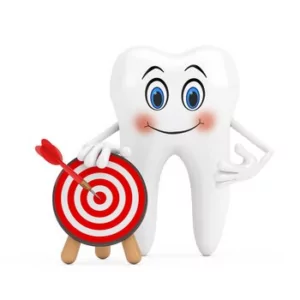In a world where digital interactions drive most communication, a business’s online presence is its lifeline. Dental practices, despite being a brick-and-mortar enterprise, are no exception to this rule. The cornerstone of a potent online presence? Search Engine Optimisation (SEO). To truly appreciate the gravitas of SEO for dental practices, we need to unravel the layers beneath its surface.
What SEO Stands For
SEO, an acronym for Search Engine Optimisation, isn’t merely a buzzword tossed around in tech circles. At its essence, SEO is the alchemy of fine-tuning various elements of a website (both on the surface and behind the scenes) to make it palatable for search engines like Google, Bing, and Yahoo.
This means tweaking on-site content, ensuring swift loading times, creating relevant meta tags, and building reputable backlinks from other sites. When harnessed effectively, SEO can be the golden ticket that lands your dental practice on the prized first search engine results page. And, in the digital realm, this first page is prime real estate.
SEO – A Critical Component of Digital Presence
Why is the first page so coveted? Think about your own habits when using a search engine. If you’re seeking a service or an answer to a question, you’d likely trust the results appearing on the initial page, especially the top results. You’re not alone in this. Research consistently shows that most users don’t venture past the first page of search results, making those top spots fiercely competitive and immensely valuable.
Moreover, implicit trust is conferred upon those who dominate these top positions. When a dental practice appears prominently in search results, it’s not just gaining visibility; it’s also gaining a badge of trustworthiness. Search engines, especially giants like Google, are trusted by users to sieve out the best, most relevant results. Hence, a dental practice that ranks well is often perceived as reputable, trustworthy, and top-of-the-line in its field.
For dental practices, this becomes even more pivotal. Dental care is intimate; it’s personal. Patients are unlikely to entrust their oral health to a practice they deem untrustworthy. Thus, by ensuring a robust SEO strategy, dental practices aren’t merely driving traffic; they’re building patient trust and, by extension, patient loyalty.
Local Searches Dominate Dental Queries
Considering the local nature of dental practices—people often look for clinics in their vicinity—local SEO becomes indispensable. An effective SEO strategy ensures that when Mrs Smith in Brisbane searches for “best dentist near me” or “Brisbane dental clinics”, your practice shines at the top, ready to welcome Mrs Smith with open arms.
In the grand scheme of things, SEO is more than just a tool for visibility; it’s a bridge that connects dental practices with potential patients. It’s the unseen hand that guides an anxious patient seeking a root canal treatment or a parent searching for a child-friendly dentist. With the digital age in full swing, SEO’s importance for dental practices isn’t just significant; it’s monumental. And those who realise and harness its power stand poised to thrive in the competitive dental landscape of Australia.
Importance of SEO for Dental Practices
Organic Traffic Drives Growth
At its core, organic traffic is comprised of individuals who naturally discover your dental website on search engines without being directed by paid advertisements. This type of traffic is golden for several reasons. Firstly, these users are typically more engaged, having found your site based on genuine interest or need.
This genuine interest often translates to longer site visits, lower bounce rates, and higher chances of appointment bookings. For dental practices, a consistent stream of organic traffic means heightened brand visibility and the potential for increased patient intake and growth.
Local SEO Tips the Scales
When someone suffers from a toothache or requires a dental check-up, they’re more likely to search for dental clinics “near me” or in their local suburb. This is where the magic of Local SEO comes into play. By optimising for location-specific keywords, such as “dentist in Sydney” or “Melbourne dental clinic”, and ensuring accurate Google Maps listings, dental practices position themselves at the forefront when potential patients in their locality are in need. Moreover, reviews and ratings on these listings can also greatly influence a potential patient’s decision to choose one clinic over another.
Building Trust and Credibility

When SEO strategies are executed effectively, they bring users to your site and ensure that once they arrive, they’re met with a wealth of information and an intuitive interface, thus solidifying your practice’s credibility.
Stay Ahead of Competitors
The dental industry is saturated, particularly in bustling urban areas of Australia. With many practitioners offering similar services, the digital space becomes the battlefield for attention. A robust SEO strategy doesn’t just mean enhanced visibility; it means standing out in a crowded market, ensuring that when a potential patient searches for dental services, it’s your practice that they discover first.
Cost-effective Marketing
Marketing budgets can be a significant concern, especially for newly established or smaller dental practices. While avenues like Pay-Per-Click (PPC) advertising or social media campaigns have their merits, they also come with recurring costs.
SEO, on the other hand, while requiring an initial investment, yields long-term results. Once a dental practice achieves solid rankings, it can enjoy sustained visibility without the constant financial outflow associated with paid ads.
How SEO Works
The Mechanics of Search Engines
Think of search engines as massive digital libraries. Just as a librarian would use a system to categorise and retrieve books, search engines like Google use crawlers (or spiders) to “read” and index web pages. These crawlers navigate the vast expanse of the web, understanding and storing information from billions of pages.
Signals of Quality
These crawlers don’t randomly index content. They look for specific signals that indicate a page’s relevance and quality. This includes factors like how fast a page loads (site speed), how accurately a page describes its content (meta descriptions), the richness and originality of the content, and how many other reputable sites link back to it (backlinks).
On-Page vs. Off-Page SEO
Understanding the distinction between on-page and off-page SEO is paramount for dental practices. On-page SEO refers to all the tweaks and optimisations made on the actual website—things like content quality, keyword placement, meta tags, and site structure. Off-page SEO, conversely, focuses on external factors such as backlinks from other websites, social media signals, and other online endorsements. It’s akin to word-of-mouth credibility in the digital space.
Harmony is Key
Dental practices must ensure a harmonious balance between on-page and off-page SEO to ascend the search engine rankings. It’s not enough to have an excellently crafted website if no external sources vouch for its credibility.
Similarly, a plethora of backlinks will be of little help if the on-site content needs to be improved in quality and relevance. For dental practices, this means a two-pronged approach: crafting a stellar website experience and forging authentic connections in the wider digital community.
In the grand tapestry of digital marketing, SEO stands out as a pivotal thread for dental practices. Its multi-faceted approach, encompassing both technical optimisations and genuine content creation, provides a solid foundation upon which clinics can build their online reputation and patient base.
Avoiding The Pitfalls: Black Hat SEO vs White Hat SEO
In the competitive world of digital marketing, shortcuts can be tantalising, but they come with considerable risks. SEO is no exception. It’s essential to understand the stark contrast between Black Hat SEO and White Hat SEO, especially as it pertains to sustainable online success.
Black Hat SEO – The Dangerous Shortcut
Black Hat SEO encompasses tactics that attempt to trick or “game” search engines into awarding higher rankings. These techniques, like cloaking, hidden text, or using unrelated keywords, might offer short-term gains, but search engines have become adept at identifying these tactics.

White Hat SEO – The Ethical Path to Success
Contrarily, White Hat SEO focuses on employing techniques that are in line with search engines’ terms of service. It prioritises the user experience, ensuring that visitors find relevant, high-quality content when they land on a web page.
Techniques like creating engaging, informative content, optimising meta descriptions, and ensuring a responsive web design are all facets of White Hat SEO. For dental practices, this approach guarantees a top spot on the first search engine results pages and the trust and loyalty of their online audience.
While Black Hat might seem tempting due to its potential for quick wins, the risks heavily outweigh the benefits. White Hat SEO, with its emphasis on authenticity and quality, ensures dental practices flourish in the digital realm with integrity intact.
SEO and Content: The Perfect Match
If SEO is the engine driving a website’s visibility, content is the fuel. The symbiotic relationship between the two can’t be overstated. It’s where science meets art, and the results can be groundbreaking when harmonised.
Content – More Than Just Words: For dental practices, content isn’t just about populating web pages. It’s about engaging, educating, and reassuring potential patients. A meticulously crafted blog post on preventative dental care or the benefits of regular check-ups does more than boost SEO; it establishes the practice as a knowledge authority, making patients more comfortable in choosing their services.
Depth Over Breadth: In the realm of SEO, superficial content barely scratches the surface. Search engines, with their ever-evolving algorithms, now prioritise depth and relevance. A detailed guide on root canal procedures, enriched with patient testimonials, FAQs, and post-treatment care, holds more SEO weight than brief overviews. Dental practices should leverage this, transforming their website into a repository of valuable information.
SEO’s Role in the Buying Cycle
The patient journey in choosing a dental practice has become more nuanced than ever. With a world of information at their fingertips, modern patients embark on a digital journey, seeking clarity, assurance, and trustworthiness.
Information Gathering: Before making a decision, potential patients explore. They’re keen to understand procedures, weigh the pros and cons, and dispel any apprehensions they might have. SEO-optimised content that addresses these queries through blogs, videos, or infographics is pivotal in influencing their choices.
Validation Through Reviews and Testimonials: Once they’ve gathered sufficient information, patients look for validation. They scour through reviews, testimonials, and even case studies. SEO strategies that amplify the reach of positive reviews can significantly enhance a dental practice’s online reputation.
Final Decision and Action: SEO is not just about attracting potential patients but also ushering them towards taking action. Clear call-to-action prompts, easy booking systems, and quick query resolutions, all underpinned by SEO, ensure that potential patients transition from mere website visitors to actual appointments.
For dental practices, understanding the intricate dance between SEO and the patient’s buying cycle isn’t just beneficial; it’s imperative. It paves the way for not just increased visibility but genuine engagement, trust-building, and sustained
The Future of SEO for Dental Practices

Emergence of Voice Search: As we usher into an era where voice-activated assistants like Siri, Alexa, and Google Assistant become household staples, voice search is drastically reshaping the SEO landscape. For dental practices, this means understanding and integrating long-tail keywords or more natural phrasing that people might use in daily conversation. Imagine a potential patient saying, “Hey Siri, where’s the nearest dentist open now?” Optimising for such queries will be pivotal.
Artificial Intelligence and SEO: The integration of AI in search algorithms is no longer a distant dream; it’s our present reality. Tools like Google’s RankBrain are harnessing AI to decipher user intent and deliver more precise search results. For dental practices, it translates to offering content that isn’t just keyword-rich but deeply aligned with potential patients’ genuine needs and questions.
Staying abreast with these seismic shifts is no easy feat. It requires not just awareness but the expertise to implement changes effectively. That’s where SEO professionals come into play. Those specialising in the intricacies of dental practices bring a blend of industry knowledge and SEO acumen to the table.
By partnering with a forward-thinking SEO company, dental practices can not only navigate the complexities of ever-evolving SEO trends but also solidify their online foothold, ensuring they remain the go-to choice for their audience.
Local SEO: The Crown Jewel for Dental Practices
In the realm of SEO, if there’s a force multiplier for dental practices, it’s indisputably local SEO. While broader SEO strategies focus on a global or national audience, local SEO hones in on capturing the community’s attention right at a dental practice’s doorstep.
The Power of ‘Near Me’ Searches: The rise in mobile search has ushered in a significant uptick in ‘near me’ queries. Patients aren’t just looking for ‘best dental practices’; they’re searching for ‘best dental practices in Sydney’ or ‘emergency dental clinics near me’. This geo-specificity is the heart and soul of local SEO. For dental practices, this means ensuring their online presence resonates with local relevance.
Local Keywords – More than Just a Location: Harnessing the power of local SEO isn’t as simple as just tagging a location to existing keywords. It’s about understanding the local lingo, the specific concerns of the community, and even the local competition. By tailoring content and SEO strategies around these nuances, dental practices can achieve higher search engine rankings, outpacing local competitors.
Directory Listings and Reviews: The cornerstone of effective local SEO lies in accurate directory listings. Platforms like Google My Business aren’t just directories; they’re digital touchpoints where potential patients assess credibility based on reviews, operational hours, and even direct Q&A. Ensuring these listings are accurate, complete, and peppered with positive patient testimonials can significantly elevate a dental practice’s local prominence.
Understanding User Intent in SEO for Dentists
One often overlooked component of SEO is understanding user intent. Search engines have grown sophisticated over the years, evolving from simple keyword matching to discerning the searcher’s intent. For dental practices, this means going beyond targeting keywords like “dentist” or “teeth whitening” and diving into what potential patients genuinely want.
Imagine a user typing “pain in the back of my mouth.” They might be seeking information on wisdom teeth issues, or perhaps they’re looking into gum diseases. By offering detailed content on various dental conditions and their symptoms, dental websites can cater to a broader spectrum of search queries, showcasing their expertise and care levels.
Voice Search: The Next Frontier for Dental SEO
With the proliferation of smart devices, like Google Home and Amazon Echo, voice search is no longer a novelty—it’s rapidly becoming a staple. When people use voice search, their queries tend to be more conversational.
For instance, instead of typing “dentist Sydney,” they might ask, “Who’s the best dentist in Sydney?” Dental practices need to anticipate these shifts in search behaviour, ensuring their content resonates with the evolving digital language of potential patients.
Emphasis on Mobile Optimisation
It’s no secret that smartphones dominate the digital landscape. For many, the phone is the primary device for accessing the internet. As such, Google has rolled out mobile-first indexing, placing a premium on mobile-optimised websites. Dental practices that ignore this shift risk being left behind.
Mobile optimisation isn’t just about a responsive design that looks good on phones, but it’s also about ensuring fast load times, easy navigation, and providing information that mobile users typically seek, like quick access to calling the clinic or viewing appointment schedules.
Structured Data: Enhancing SERPs Appearance
Structured data or schema markup allows websites to provide search engines with additional information about their content. For dental practices, this can be game-changing. By using structured data, practices can highlight patient reviews, services, operating hours, and even price ranges for treatments in the search results.
Imagine a searcher comparing two SERP entries: one is a plain listing, and the other, using structured data, showcases five-star reviews, indicates it offers emergency dental services, and provides a link to book an appointment. The latter is more likely to capture attention and clicks.
Keeping Pace with Algorithm Updates
Search engines, especially Google, are notorious for periodically updating their algorithms. These updates can sometimes drastically alter search rankings. Dental practices committed to maintaining a robust online presence must stay attuned to these changes. It’s not just about understanding these updates but being agile enough to adapt and re-strategise as required.
Interactive Content: The Rise of Video and Multimedia
Gone are the days when websites were static repositories of text. Modern users crave interaction and engagement. Dental practices can tap into this by incorporating multimedia content into their SEO strategy.
For instance, a short video demonstrating proper brushing techniques or explaining common teeth scaling procedures can make content more digestible and engaging. Such multimedia content doesn’t just enhance user experience; search engines too favour websites that engage visitors for longer durations, signalling the site’s quality and relevance.
Building an Inclusive Web Experience: Accessibility and SEO
Web accessibility, ensuring that websites are usable for people with disabilities, isn’t just a moral imperative—it’s becoming an SEO consideration. Search engines value websites that offer a superior, inclusive user experience.
Dental practices can bolster their SEO efforts by ensuring their site is navigable with keyboard shortcuts, content is readable with screen readers, and multimedia elements have appropriate captions or descriptions.
Embracing E-A-T for Dental SEO
E-A-T stands for Expertise, Authoritativeness, and Trustworthiness. Google search quality guidelines emphasise E-A-T as a critical factor in ranking, especially for medical websites. After all, users should get accurate medical information from trustworthy sources.
For dental practices, this means ensuring that content is not only factually accurate but is also authored or vetted by professionals with credentials in the field. Highlighting dental professionals’ expertise, qualifications, and associations can lend significant weight to a dental practice’s online content.
In Conclusion
The digital landscape offers boundless opportunities for dental practices. With a robust SEO strategy, dental practices can ensure they’re visible to potential patients at the right time. And as emphasised throughout this article, the importance of SEO cannot be understated.
The quest to understand and capitalise on SEO may seem daunting. It’s a continuous process of learning, adapting, and optimising. But with the right strategy and partner, it’s a journey that promises substantial rewards. Are you ready to leverage the power of SEO for your dental practice? Reach out to Mediboost today, and let’s craft an SEO strategy tailored to your success.
References:
https://www.geeksforgeeks.org/10-reasons-why-seo-is-important-for-a-website/
https://nextjs.org/learn/seo/introduction-to-seo/importance-of-seo






